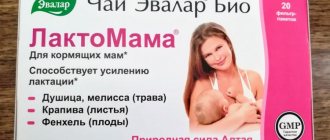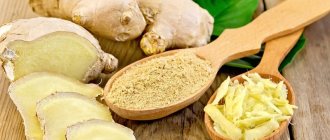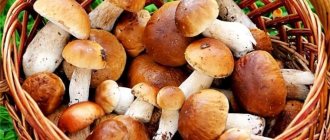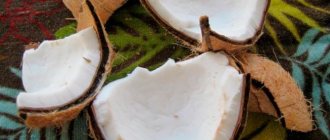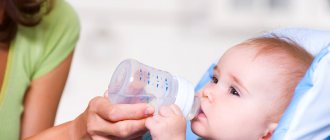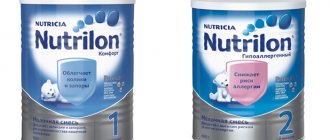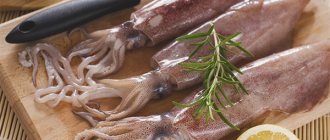Causes of regurgitation
First, let's look at the causes of regurgitation, which occurs in most babies and should not cause concern to parents:
- Immaturity of the digestive system
. In an adult, a special muscular valve or sphincter is located between the stomach and esophagus. It's called Cardia. This valve prevents food from being thrown back into the esophagus. In babies under six months it is not sufficiently developed. Therefore, any contraction of the stomach walls causes regurgitation or reverse reflux. This is the absolute norm for all children. Most often, by the age of 6 months everything goes away. In rare cases, it continues until the age of one. - Binge eating
. Babies do not always eat as much as they need; they often eat as much as they can fit. And the body already regulates the required amount of food by regurgitating excess. This reason for regurgitation is typical for artificial babies. The mixture comes through the nipple more easily than from the breast. The baby eats faster than he feels full. That's why overeating happens. - Swallowing air with food
. In this case, the air comes back out along with the milk, and the baby spits up. - Gas and colic
. They can also cause reflux. Air bubbles press on the walls of the intestines and stomach and promote the return of food to the esophagus. - Increased nervous excitability
. When the baby is worried, the walls of the stomach begin to contract and the milk consumed is returned.
Alarming symptoms that are a reason to immediately consult a doctor are most often accompanied by disturbances in weight gain, since the milk eaten is not absorbed by the body:
- Frequent regurgitation in a fountain
. It may be an indicator of lactase deficiency - in other words, the inability to digest milk. Read more about lactase deficiency in our article. Fountain burping can also occur due to improper development of the baby's digestive system. - Regurgitation of milk that is yellowish or greenish in color
. May be an indicator of an infectious disease. Or occur as a result of the reflux of bile into the stomach. The baby will most likely behave restlessly, since bile irritates the walls of the stomach.
But how can you determine the cause of reverse reflux? In fact, this is not necessary! There is only one indicator that is important to monitor - weight gain. If your baby is gaining weight normally and you are not experiencing any alarming symptoms, then there is no reason to worry. The spitting up will stop on its own as the baby gets older.
Regurgitation after formula feeding
This is not to say that regurgitation after formula feeding is more common than with breast milk. However, it happens that the mixture is not suitable for the baby due to the characteristics of the composition. In any case, we remember that if profuse regurgitation occurs like a fountain after the mixture, then there is an indication to consult a doctor. And this must be done immediately.
The pediatrician will determine the cause. And if it is in the mixture, then he will prescribe a different or special anti-reflux mixture.
What are antireflux mixtures?
This type differs from the standard product in its composition, which includes a special thickener. Thanks to the viscous component, food for the baby becomes thicker, the risk of backflow of food from the stomach into the esophagus is reduced, and the passage of digested food through the intestines is accelerated. The product is considered a therapeutic food, so it can only be used after consultation with a pediatrician. Even manufacturers of specialized formulas indicate in the instructions that the main source of substances necessary for the development of a child is mother’s milk.
Antireflux products are labeled “AR” or “AR” and are prescribed for:
- intestinal dysfunctions;
- regular constipation;
- increased gas formation, colic;
- gag reflex;
- profuse regurgitation.
The thickener enters the stomach along with a portion of food, the fibers begin to absorb liquid in the baby’s stomach, after which they enter the intestines and are naturally excreted from the body. The peristalsis of the gastrointestinal tract and the process of digestion of food improves. The thickener is natural gum or starch - usually rice. Their main task is to “bind” liquid food to prevent regurgitation.
Various components of the product have an individual effect on the child’s gastrointestinal tract, which must be taken into account when using. Nutrilon Antireflux contains locust bean gum fibers; in others, the astringent ingredient is its soluble analogue or starch. Intuitively choosing the best option based on product characteristics and online reviews will not work.
Important! It is strictly prohibited to introduce anti-reflux baby food into your baby’s diet on your own. Like a therapeutic diet, a specialized mixture is prescribed by a doctor after examining the baby.
How to reduce spitting up
It is not possible to completely get rid of the natural process of returning food, but you can make this process easier for the baby and parents.
- Carry your baby upright after feeding. This way, the air he swallowed during feeding will come out faster.
- Make sure that the baby covers the entire circumference of the nipple. Then air will not penetrate when sucking.
- Use anti-colic nipples when bottle feeding. They are designed to keep air out.
- After feeding, do not entertain the baby, let him be alone for a while.
- Try feeding for a little less time to prevent overeating.
- Give your baby a pacifier before bed to stimulate digestive activity for a while after eating.
- Provide your baby with more movement: exercise, massage, swimming, tactile contact, walks in the fresh air. So that the muscular system develops more actively. All internal organs will develop along with it.
There is no medicine that will reduce regurgitation. Because this is not a disease, it is either a symptom or a natural process.
The only thing that can affect the amount of food returned is the use of anti-colic drugs, which reduce gas formation in the intestines. Their use is justified only if the baby is tormented by gas. Pay attention to the Israeli drug for colic Simicol, which is suitable for infants from birth.
Preparing the mixture
Before diluting the powder product, you need to sterilize the bottle with nipple and wash your hands thoroughly. The mixture is prepared immediately before feeding according to a single scheme:
- Pour boiled water (cooled to 37-40°C) into the bottle in the required quantity.
- Add the dry mixture in the proportion of 1 scoop per 30 ml of water.
- Close the bottle with a lid and mix the mixture well in a circular motion until the dry component is completely dissolved.
- Before feeding, the temperature of the finished food must be checked. You need to drop a few drops from the bottle onto the inside of your wrist - the mixture should not be scalding hot or too cold.
When the baby is active, in a good mood, gaining weight and not being capricious, it is better to simply wait out the period of regurgitation. This is a normal physiological phenomenon, which is explained by the maturation characteristics of the infant’s gastrointestinal tract. If the return of food causes concern among parents, a consultation with a pediatrician will be needed. He will be able to reassure the mother and explain whether there are indications for the use of Nutrilon Antireflux in a particular case.
Nutrilon Antireflux
Nutrilon® Antireflux
, in medical articles it is often called
Nutrilon AR
or
Nutrilon AR
- an infant dry formula with nucleotides for feeding children with regurgitation problems. Nutrilon Antireflux effectively eliminates regurgitation, as it contains a natural thickener - locust bean gum (gum is recognized by international experts as an effective and safe component for antireflux mixtures).
Nutrilon Antireflux can be used as a supplement to breast milk (if breast milk is not enough) or as a basic formula for regurgitation syndrome, as it contains all the necessary ingredients for the growth and development of the baby. The mixture also contains a complex of special fatty acids ARA/DHA, which promotes the development of intelligence.
Composition of Nutrilon® Antireflux infant formula
Lactose, skim milk, mixture of vegetable oils (palm, rapeseed, coconut, sunflower, Mortierella alpina
with a high content of arachidonic acid), maltodextrin, thickener - carob gum, sources of minerals (calcium carbonate, iron sulfate, zinc sulfate, copper sulfate, manganese sulfate, potassium iodide, sodium selenite), fish oil, vitamin sources (L-ascorbic acid, sodium L-ascorbate, DL-alpha-tocopherol acetate, nicotinamide, folic acid, calcium D-pantothenate, retinol palmitate, DL -alpha-tocopherol, D-biotin, thiamine hydrochloride, cyanocobalamin, colecalciferol, pyridoxine hydrochloride, phytomenadione), L-cysteine, emulsifier - soy lecithin, taurine, nucleotides (uridine 5-monophosphate sodium salt, cytidine 5-monophosphate, adenosine 5- monophosphate, inosine 5-monophosphate sodium salt, guanosine 5-monophosphate sodium salt), choline chloride, inositol, L-carnitine.
Nutritional value (average values)
| Indicator name | Unit measurements | Per 100 g of powder mixture | Per 100 ml of prepared mixture |
| Protein | G | 12,3 | 1,6 |
| Casein/whey proteins | % | 80/20 | |
| Taurine | mg | 38 | 5 |
| L-Cysteine | mg | 153 | 20 |
| Fats | G | 26,4 | 3,5 |
| vegetable | G | 25,9 | 3,4 |
| linoleic acid | G | 3,53 | 0,466 |
| linolenic acid | G | 0,652 | 0,086 |
| arachidonic acid (ARA) | mg | 88 | 12 |
| docosahexaenoic acid (DHA) | mg | 50 | 6,7 |
| Carbohydrates | G | 51,6 | 6,8 |
| lactose | G | 45,4 | 6,0 |
| % of total carbohydrates | 88,0 | 88,0 | |
| Dietary fiber (gum) | G | 3,0 | 0,4 |
| Minerals | |||
| Sodium (Na) | mg | 181 | 24 |
| Potassium (K) | mg | 577 | 76 |
| Chlorides (Cl) | mg | 394 | 52 |
| Calcium (Ca) | mg | 586 | 77 |
| Phosphorus (P) | mg | 329 | 43 |
| Magnesium (Mg) | mg | 39 | 5,1 |
| Ca/P | 1,8 | ||
| Iron (Fe) | mg | 5,1 | 0,68 |
| Zinc (Zn) | mg | 4,5 | 0,59 |
| Copper (Cu) | mcg | 302 | 40 |
| Manganese (Mn) | mcg | 249 | 33 |
| Selenium (Se) | mcg | 9,8 | 1,3 |
| Iodine (I) | mcg | 99 | 13 |
| Vitamins | |||
| Vitamin A | µg RE | 378 | 50 |
| Vitamin D3 | mcg | 9,1 | 1,2 |
| Vitamin E | mg α-TE | 7,7 | 1,0 |
| Vitamin K1 | mcg | 34 | 4,5 |
| Vitamin B1 | mcg | 409 | 54 |
| Vitamin B2 | mcg | 747 | 99 |
| Niacin | mg | 3,3 | 0,44 |
| Pantothenic acid (B5) | mcg | 2243 | 296 |
| Vitamin B | mcg | 351 | 46 |
| Folic acid | mcg | 71 | 9,4 |
| Vitamin B12 | mcg | 1,3 | 0,17 |
| Biotin | mcg | 11 | 1,5 |
| Vitamin C | mg | 63 | 8,3 |
| Inositol | mg | 25 | 3,3 |
| Kholin | mg | 58 | 7,7 |
| L-Carnitine | mg | 6,8 | 0,9 |
| Nucleotides | mg | 24 | 3,2 |
| Energy value | kcal (kJ) | 499 (2085) | 66 (275) |
| Osmolality | mOsm/kg | 290 | |
Manufacturer
The manufacturer of Nutrilon Antireflux milk formula is Nutricia (Netherlands), a division of Danone.
Materials for healthcare professionals regarding the use of anti-reflux infant formulas, including Nutrilon® Antireflux
Articles
- Babayan M.L. Modern approaches to the correction of regurgitation in young children // Perspectives of medicine. Pediatrician practice. 2013. March-April. pp. 31–35.
- Privorotsky V.F., Luppova N.E., Belmer S.V. and others. Working protocol for the diagnosis and treatment of gastroesophageal reflux disease in children (parts 1, 2) // Questions of pediatric dietology. – 2015. – T. 13. – No. 1, pp. 70-74, no. 2, pp. 52-56..
On the website GastroScan.ru in the “Literature” section there is a subsection “Refluxes, regurgitation, regurgitation in children”, containing publications for healthcare professionals on this topic.
Video
Video lecture by S.V. Plyasovskaya-Akhmetova “Diagnostics and stages of helping children with regurgitation” contains a lot of information on the use of the Nutrilon Antireflux mixture.
Nutrilon Antireflux milk formula has contraindications, side effects and application features; consultation with a specialist is necessary.
Back to section


